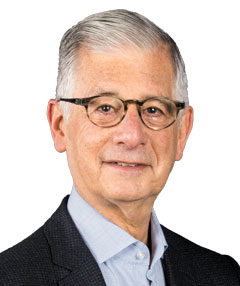Steve Goldsmith: Bold vision and leadership has paid off
Indianapolis and IBJ have much to celebrate looking back over the last 40 years. Four decades ago, I had recently begun my first term as Marion County prosecutor. Former Mayor Dick Lugar’s vision of a combined city-county government that didn’t give up on its core continued to demonstrate its impact. IUPUI, the result of Lugar’s call for “a great state university in Indianapolis” had commenced a steady path of progress.
These initiatives need to be viewed within the demographic context that these mayors and those that followed them (including this writer), faced. Lugar took over a shrunken city where many middle-class and white families had moved out of the urban core and into outlying portions of the county.
Lugar engineered Unigov, the transformative merger of the city and county, which provided the foundation of this 40 years of success. All the mayors under Unigov realized that, if wealth fled, leaving a densely poor urban core, the result would eventually be a city that failed to meet its potential and failed many of its residents.
One of the most important pillars of the Indianapolis success, its amateur sports initiative, had commenced, under the leadership of Mayor Bill Hudnut and supported by attorney David Frick; Jim Morris, Lugar’s former deputy mayor and now Indiana Pacers president; and Bank One President Frank McKinney Jr. However, even with this foundation of success, by the time I became mayor in 1991, the phenomenon that Unigov ameliorated had repeated itself as families had continued to spill into adjoining counties.
In the 1990s, we tried to blend together four themes that we hoped would leverage the initiatives of my predecessors in important ways. We wanted the center of the city to be a place for job growth, for emerging tech talent but also for the retail and service jobs so desperately needed as a place for many urban residents to begin their careers. Thus, that decade saw the construction of major parts of the convention center, hotels, Circle Centre mall and the Pacers fieldhouse, and major initiatives to induce the growth or relocation of downtown jobs, including at Eli Lilly and Co. and Anthem Inc.
Second, we positioned downtown to once again be a neighborhood where people wanted to live, and thus launched the construction of amenities to change its attractiveness, including development along the Central Canal, White River State Park improvements, the beginning of the arts and cultural area along Massachusetts Avenue, and more.
Third, Indianapolis’ older neighborhoods, many of them poor and exclusively minority, needed a fair shake—thus the Building Better Neighborhoods initiative that plowed more than $500 million into rebuilding the infrastructure in these areas. And finally, Indianapolis had become challenged by its low-cost neighbors and had to tighten its belt in order to position itself as one of America’s best-managed cities.
During the 40 years we are celebrating, we saw success, but more obstacles as well. As mayor and as a graduate of Broad Ripple High School, I worried greatly about Indianapolis Public Schools’ results generally, and for young people of color in particular. Graduation rates had plummeted, and eventually the system lost almost two-thirds of its students. Mayor Bart Peterson would lead a major initiative to strengthen the system, which was continued by his successor, Greg Ballard.
What can we then claim from the last 40 years? A city that blends the very best of civic spirit and volunteerism with physical changes to become internationally known as a place to work, visit and live, headlined by a vibrant core. Thousands have moved back into the city; almost 75,000 hospitality jobs have been created. The tech sector, as we had hoped, has produced entrepreneurial and large-company tech jobs epitomized by Salesforce Tower. And many of our neighborhoods, including downtown, have strengthened.
Yet we also see that poverty has essentially doubled in the last 20 years, accompanied by an accelerated suburban flight. Race and justice issues, long a challenge of a city with a history of segregated schools and housing, demand attention.
For 40 years, Indianapolis outperformed its competition while becoming a healthier and more vibrant city. It accomplished this result not by accident, but with a bold vision executed by a combination of municipal, political, neighborhood and corporate leadership.
Indianapolis is once again at a point that requires us to summon the very best in us. We will need to find ways to overcome the changes in retail patterns accelerated by COVID-19 that will deal a permanent blow to many retail jobs and retailers. If we can overcome current limitations inflicted by poverty, bias and lack of education and opportunity, and place underemployed individuals in better-paying jobs, we can add more than $1 billion to our local economy.
Indianapolis’ successes have evolved from intentionality, not accident. Reaching the next stage will require the same.•
__________
Goldsmith was mayor of Indianapolis from 1992 to 2000. He is now a professor of urban policy and director of the Innovations in American Government Program at Harvard University’s Kennedy School of Government.
Please enable JavaScript to view this content.







